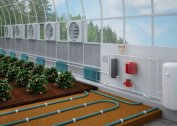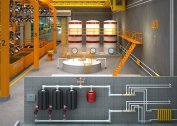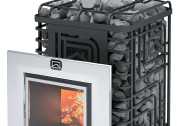Such designs will be very handy for rooms in which we do not have to be too often. They are perfect for country houses, garages, repair boxes, utility rooms. As a rule, it is impossible to conduct a centralized heating system here, and it may be necessary to warm them up during the cold season. Therefore, we have to look for alternative types of heating for such facilities.
Principle of operation
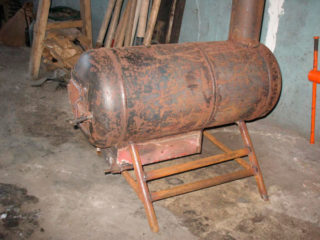 Due to its design features, stoves of this sample heat up quite quickly. At the same time, the time required to achieve the optimum temperature will not need too much. However, due to the small thickness of the walls of the cylinder, the structure cools down as quickly as it glows. To eliminate this drawback, it is recommended to overlay the stove with a brick, while the speed of its heating will remain the same, and it will cool much more slowly.
Due to its design features, stoves of this sample heat up quite quickly. At the same time, the time required to achieve the optimum temperature will not need too much. However, due to the small thickness of the walls of the cylinder, the structure cools down as quickly as it glows. To eliminate this drawback, it is recommended to overlay the stove with a brick, while the speed of its heating will remain the same, and it will cool much more slowly.
The main structural element is a steel casing with dampers through which the fuel is supplied, as well as the circulation of air necessary for the combustion process. The heating process itself is quite simple - through the upper flap inside the potbelly stove the required amount of fuel is laid, and then the ignition takes place. As a result of its combustion, a large amount of heat is released, which heats the walls of the cylinder and warms the air in a heated room. The smoke remaining after burning fuel is discharged outside the structure using a chimney - a pipe installed in the upper part of the structure. It is best to make it in the form of several elbows, since the direct shape will remove some of the heat along with the smoke. The cranked shape of the chimney will maintain the efficiency of the heater.
As a fuel, you can use various materials - coal, wood, old things and even household garbage. You can also cook food on the stove, so its presence on the farm will be very useful.
How to make such a design
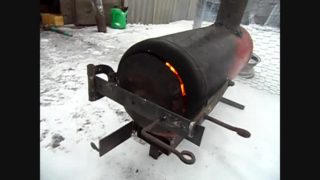 After using gas cylinders, they still contain a small concentrate of the remainder of the mixture, which is very explosive. Therefore, before proceeding with the cutting of the tank, it is necessary to drain the remaining gas and drain the condensate. To do this, we unscrew the valve and allow the contents to go outside. Then we turn the balloon upside down and carefully drain the condensate into a plastic container. It is necessary to ensure that it does not get on the surface of the floor, because its smell is quite pungent and very long disappears. After condensate has been removed, the container is returned to its previous position, we fill it with water and let it stand for several hours. After some time, the water can be drained. Thus, we remove the last drops of the gas mixture, after which we can proceed to cutting the cylinder.
After using gas cylinders, they still contain a small concentrate of the remainder of the mixture, which is very explosive. Therefore, before proceeding with the cutting of the tank, it is necessary to drain the remaining gas and drain the condensate. To do this, we unscrew the valve and allow the contents to go outside. Then we turn the balloon upside down and carefully drain the condensate into a plastic container. It is necessary to ensure that it does not get on the surface of the floor, because its smell is quite pungent and very long disappears. After condensate has been removed, the container is returned to its previous position, we fill it with water and let it stand for several hours. After some time, the water can be drained. Thus, we remove the last drops of the gas mixture, after which we can proceed to cutting the cylinder.
Varieties of these heating systems
Now you need to decide what type of heater we need. There are two types of these structures - vertical and horizontal. All of them have their own technical features, so it is worthwhile to dwell on them in more detail.
Horizontal system
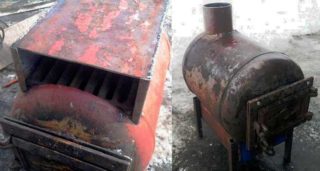 To make such a furnace, the cylinder is placed in a horizontal plane, and then its upper part is cut off. After its removal, we get free access to the inside of the tank, we can install a grate there, which is made of steel reinforcement and welded to the main structure.
To make such a furnace, the cylinder is placed in a horizontal plane, and then its upper part is cut off. After its removal, we get free access to the inside of the tank, we can install a grate there, which is made of steel reinforcement and welded to the main structure.
The front part of the heater is made of sheet metal, on which the contours of a circle equal to the diameter of the cylinder will be marked.Then we cut the part along the marked edges and outline two rectangles on it - this will be a damper and a blower. They are also cut out by a grinder. Hinges are welded to them, and installation on the finished structure takes place. So that the finished flaps are denser adjacent to the stove, their circuit can be sealed with asbestos-cement cord. Then we will use them to supply fuel and adjust the heating temperature.
A round hole must also be made in the back of the structure. It will be designed to install a chimney. The size of the hole must match the diameter of the pipe, which we subsequently weld to the potbelly stove. For the manufacture of the chimney, it is best to choose a thick-walled pipe, since it can also be used as a heater.
Vertical system
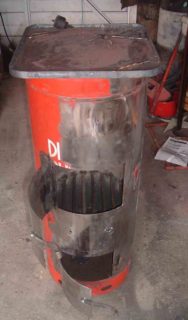 In this case, the cylinder is installed in an upright position. True, there are two ways to make a heating system. The first option involves the removal of the upper part of the cylinder, and in the second case this is not required. It is, of course, advisable, nevertheless, to get rid of unnecessary details that will interfere with us during work. The rest of the preparatory process is similar to the previous one:
In this case, the cylinder is installed in an upright position. True, there are two ways to make a heating system. The first option involves the removal of the upper part of the cylinder, and in the second case this is not required. It is, of course, advisable, nevertheless, to get rid of unnecessary details that will interfere with us during work. The rest of the preparatory process is similar to the previous one:
- we manufacture and install grate;
- grinder or chisel cut the upper and lower shutters. Their sizes can be different, the main thing is that the operation of the finished product is convenient and safe;
- weld loops to them and install on the front of the stove. Their edges should also be pasted over with an asbestos-cement cord;
- cut a hole under the chimney. It can be made at the top of the structure on the side or directly on the cylinder cover.
After carrying out all the activities, the design is ready for use. However, it should be remembered that such heating systems strongly burn oxygen in the room, so it is sometimes necessary to ventilate it. You must also comply with all fire safety rules. And then we will not have any problems with the use of the stove.
